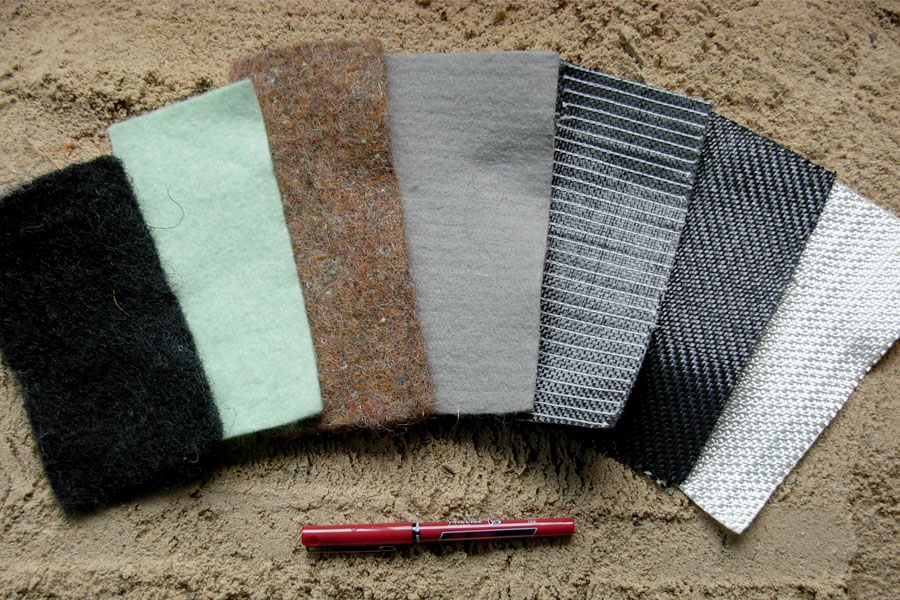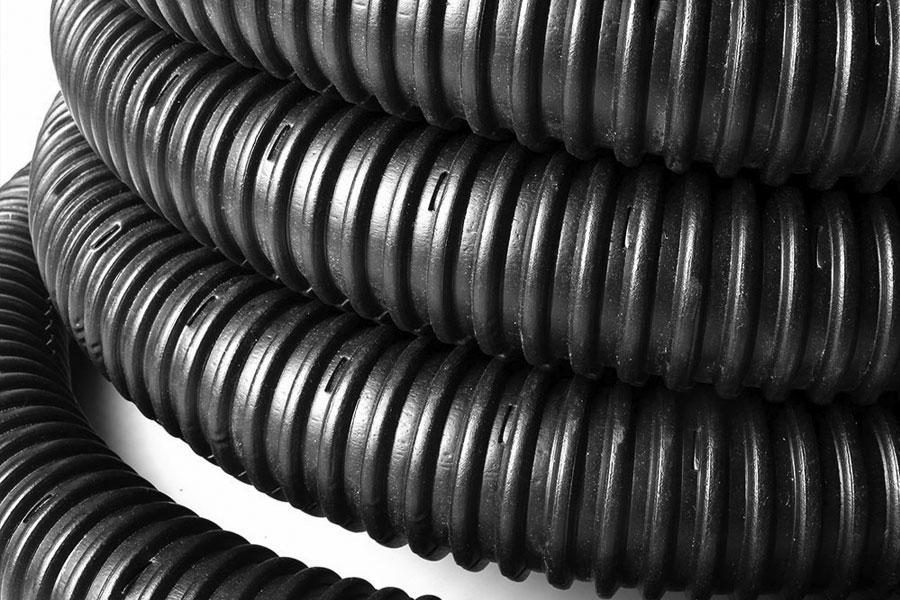🕑 Reading time: 1 minute
Geosynthetics are artificial synthetic materials made of polymeric or natural materials in the form of strips, a sheet, or a three-dimensional structure. They are easy to prepare and transport, and can help make construction projects more eco-friendly. They perform five pivotal functions when applied in construction – separation, reinforcement, filtration, drainage, and containment.
Contents:
1. Geotextiles
Geotextiles are permeable fabrics made of polyester or polypropylene. They are the oldest and the largest group of geosynthetics in terms of volume and are used in construction for erosion control, separation, drainage, soil stabilization, filtration, and reinforcement.
There are three main types of geotextiles that support different applications – woven fabrics, knitted fabrics, and non-woven fabrics. They are mostly consumed in the construction of roads. Apart from roads, geotextiles are used in other infrastructure works such as landfills, pipelines, drainage structures, railways, and various other civil projects.

Non-woven geotextiles are generally used in the construction of tunnels in hilly regions. The use of geotextiles brings the benefits of reduced maintenance costs and longer life cycle of the infrastructure asset.
2. Geogrids
Geogrids are polymeric materials formed by extrusion, weaving, or welding to form open aperture products of varying strength, strain, and load-carrying capability for applications of soil reinforcement.
Polymeric materials such as polyester, high-density polyethylene, and polypropylene are the main components of geogrids. Geogrids are commonly used to reinforce sub-bases or subsoils below roads, as well as retaining walls or other structures. Geogrids were once used only for the construction of retaining walls. Now, geogrids are used in many other structures like dams and pavements due to their ability to redistribute load over a wider area, high holding capacity, high tensile strength, and eco-friendly nature.

They are also applied to stabilize the subgrade for construction of embankments in the railway and highway sectors and in the stabilization of soils with high water table levels or low bearing strength where laying of foundations to carry heavy loads becomes critical.
3. Geomembranes
Geomembranes are low-permeability plastic sheets with a 0.5-3mm thickness and are used primarily for linings and covers of solid or liquid storage facilities. Geomembranes control the fluid movement and are highly impermeable. The age and performance of the membranes depend upon the material used to produce them. Because of their impermeability, they can help prevent contaminant diffusion, which is particularly important for waste management. Apart from this, geomembranes find their use in pond/land/tunnel/canal lining, and environmental, transportation, and oil and gas applications. However, geomembranes are more expensive when compared to other geosynthetic products.
4. Geonets
Geonets or Geospacers have a structure similar to Geogrids. They are formed by a continuous parallel set of polymeric ribs at acute angles to one another, forming a net-like pattern. They are obtained by welding of threads/bands or press forming of thermoplastic polymers. Their area of function lies within the drainage area, where they are used to convey fluids of all types. Geonets find their application in foundation walls, landfills, methane roads, asphalt concrete pavements, and drainage and erosion control. The drainage core provides lateral drainage of fluids in all directions, whereas the geotextiles function as a filter media and prevent the surrounding fill from clogging the drainage core. The hardness properties of a geonet allow it to sustain a considerable amount of load.

5. Geosynthetic Clay liners
Geosynthetic clay liners consist of two layers of non-woven geotextiles sandwiched with a layer of sodium bentonite powder in between.
The two layers of geotextiles are stitched together by sewing process (needle-punched non-woven), creating a perfectly balanced mat with an internal shear resistance.
When it comes in contact with water, the sodium bentonite in the mat puffs up and creates a waterproof mineral layer.
Geosynthetic clay liners are used as hydraulic barriers for water, leachate, or other liquids and even gases. They are also used as a substitute for either geomembranes or compacted clay liners, or are used in a composite manner to enhance the more traditional liner materials.
Common lining applications of geosynthetic clay liners include use in stormwater impoundments and wetlands, canals, in highway and civil construction, for secondary containment, and as landfill liners and landfill caps, and mines.
6. Geofoams
Geofoams are blocks or slabs obtained by the expansion of polystyrene foam to form a low-density network of closed, gas-filled cells. They are light in weight and can bear rough conditions. They are also used as a filler material to reduce lateral pressures on retaining walls or stresses on underlying soils, foundations, or abutments. Their low cost and better environmental sustainability make them very popular, and the demand for geofoams is expected to rise in the near future.

7. Geocells
Geocells, or cellular confinement systems, are drawn from ultrasonically welded high-density polyethylene (HDPE) strips and are expandable on-site to form a honeycomb-like pattern. The cells are filled with compact non-cohesive soils that are restricted within the cellular walls, and the composite develops a rigid to semi-rigid structure.

The key features of geocells are aging resistance, high durability, chemical resistance, and innate flexibility. In construction, they are used for channel protection, soil stabilization on flat ground and steep slopes, erosion control, and structural reinforcement for load support and earth retention.
Geocells offer a feasible solution for strengthening and fixing the water accumulation problem and the soil erosion problem in the widening of highways.
8. Geopipes
Geopipes are perforated or solid-wall polymeric pipes used for drainage of gases and liquids. In some cases, the pipe is wrapped with a geotextile filter. They are mainly used in case of high compressive loads and for leachate collection. Geopipes are used for landfill applications to facilitate collection and quick drainage of the leachate to a sump and removal system.

9. Geocomposites
Geocomposites are geosynthetics made from a mixture of two or more geosynthetics such as geonet-geotextile, geogrid-geotextile, and geomembrane-geonet. These different combinations provide benefits over single layers of geosynthetics by enhancing functions and increasing interface friction angles and installation speed.

They are essentially used for separation, reinforcement, filtration, drainage, and containment. Based on their functions, the geocomposites market is divided into three parts– containment, drainage, and others.
Of these, it is prevalent in the drainage segment, for road and civil construction, pavement base course or edge drains, trench drains, tunnels in railways and roads, rooftops, retaining walls and bridge abutments, and other applications.
FAQs
Geosynthetics are artificial synthetic materials made of polymeric or natural materials in the form of strips, a sheet, or a three-dimensional structure.
Geosynthetics perform five pivotal functions when applied in construction – separation, reinforcement, filtration, drainage, and containment.
Geocells, or cellular confinement systems, are drawn from ultrasonically welded high-density polyethylene (HDPE) strips and are expandable on-site to form a honeycomb-like pattern. The cells are filled with compact non-cohesive soils that are restricted within the cellular walls, and the composite develops a rigid to semi-rigid structure.


